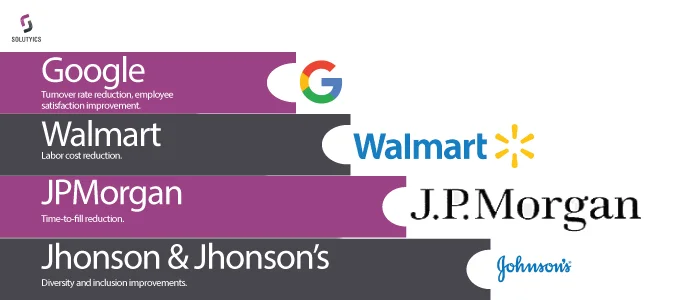
Human capital refers to the collective skills, knowledge, experience, and attributes of individuals within a workforce, which can be viewed as valuable assets to an organization. It encompasses the education, training, and expertise that employees bring to their roles, as well as their ability to contribute to the productivity and success of a business. Human capital is a critical component of a company’s overall value and competitiveness, as it directly influences the organization’s capacity for innovation, problem-solving, and sustainable growth. Recognizing and investing in the development of human capital is essential for fostering a skilled and effective workforce and maintaining a competitive advantage in the market.
Human capital analytics
Human capital analytics, on the other hand, involves the systematic analysis of this human capital data to provide insights and inform decision-making processes related to human resources, talent management, organizational development, and overall workforce strategy. It encompasses a wide range of data-driven approaches to understanding and maximizing the value of the human capital within an organization. This can include analyzing employee performance, engagement, training and development, succession planning, and other workforce-related metrics to optimize the organization’s human capital strategy.
Here’s how it works:
Employee Performance Analysis: By collecting and analyzing data on individual and team performance, organizations can identify top performers, assess productivity levels, and recognize areas where additional support or training may be needed.
Employee Engagement Assessment: Through the analysis of employee surveys, feedback, and other relevant data, organizations can gauge the level of employee satisfaction, motivation, and overall engagement within the workforce. This information helps in devising strategies to improve workplace morale and foster a positive work environment.
Training and Development Evaluation: Human capital analytics can assess the effectiveness of training programs by tracking key performance indicators before and after training initiatives. This enables organizations to identify the impact of training on employee skill development and overall performance.
Succession Planning Analysis: By evaluating employee skills, qualifications, and career trajectories, organizations can identify potential candidates for key roles within the company. This process helps in creating a pipeline of qualified employees who can fill critical positions in the future, ensuring a smooth transition in leadership and key roles.
Workforce Strategy Optimization: Through the analysis of workforce-related data, organizations can align their human resources strategies with their overall business objectives. This includes workforce planning, talent acquisition, and talent retention strategies that are designed to maximize the value of human capital within the organization.
Key cost considerations:
The cost of implementing human capital analytics can vary depending on various factors, including the size of the organization, the complexity of the analytics tools and systems, the level of expertise required, and the scope of the analytics project.
Technology and Tools: Implementing human capital analytics often requires the use of advanced software and data analytics tools. The cost of acquiring, licensing, and maintaining these tools can constitute a significant portion of the overall implementation cost.
Data Collection and Integration: Organizations may need to invest in systems that can collect and integrate data from various sources within the organization. This can involve setting up data management systems, data warehouses, or data integration platforms, which can incur additional costs.
Training and Expertise: Organizations may need to invest in training their employees or hiring professionals with expertise in data analysis, data science, and human resources analytics. The cost of training programs or hiring specialized personnel can contribute to the overall implementation cost.
Infrastructure and Support: Ensuring that the organization has the necessary infrastructure to support the analytics implementation, including hardware, networking, and technical support, can also add to the overall cost.
Data Security and Compliance: Implementing human capital analytics may require investments in data security measures and compliance with data privacy regulations to ensure the protection of sensitive employee information. The cost of implementing robust data security measures and complying with relevant regulations should be factored into the overall cost.
Ongoing Maintenance and Updates: Regular maintenance, updates, and upgrades of the analytics systems and tools are essential to ensure the accuracy and reliability of the data. Organizations need to consider the costs associated with ongoing maintenance and updates as part of the overall implementation cost.
While the initial investment in human capital analytics can be significant, the potential long-term benefits, including improved workforce efficiency, better decision-making, and increased productivity, can outweigh the upfront costs. Additionally, organizations can choose to start with smaller-scale pilot projects or leverage cloud-based analytics solutions to manage costs effectively.
Ready to transform your workforce with data-driven success? Contact our team today and unlock the full potential of your business. Let’s shape a future of excellence together.
Real world examples

Google: Google uses human capital analytics to improve its hiring process and employee retention. The company tracks data such as employee performance, turnover rates, and employee satisfaction. Google also uses data to identify and address potential problems, such as employee burnout and discrimination. As a result of using human capital analytics, Google has been able to reduce its turnover rate by 20% and improve employee satisfaction by 15%.
Walmart: Walmart uses human capital analytics to improve its scheduling and staffing practices. The company tracks data such as employee availability, sales forecasts, and weather conditions. Walmart uses this data to create optimal schedules that ensure that there are enough employees on hand to meet customer demand. As a result of using human capital analytics, Walmart has been able to reduce labor costs by 5%.
JPMorgan Chase: JPMorgan Chase uses human capital analytics to improve its talent management process. The company tracks data such as employee performance, skills, and career goals. JPMorgan Chase uses this data to identify and develop high-potential employees. The company also uses data to create succession plans for key positions. As a result of using human capital analytics, JPMorgan Chase has been able to reduce the time it takes to fill key positions by 25%.
Johnson & Johnson: Johnson & Johnson uses human capital analytics to improve its diversity and inclusion initiatives. The company tracks data such as employee demographics, hiring rates, and promotion rates. Johnson & Johnson uses this data to identify and address potential biases in its hiring and promotion processes. As a result of using human capital analytics, Johnson & Johnson has been able to increase the number of women and people of color in its workforce by 10%
Top 5 software packages for human capital analytics:
Workday: Workday is a cloud-based human capital management (HCM) software suite that includes a variety of human capital analytics features. It can track employee performance, skills, compensation, and other key metrics. Workday also offers a variety of reports and dashboards that can help users to identify trends and areas for improvement.
SAP SuccessFactors: SAP SuccessFactors is another cloud-based HCM software suite that includes a variety of human capital analytics features. It can track employee performance, skills, compensation, and other key metrics. SAP SuccessFactors also offers a variety of reports and dashboards that can help users to identify trends and areas for improvement.
IBM Watson Talent: IBM Watson Talent is a cognitive computing platform that can be used to analyze human capital data. It can identify patterns and trends that humans may not be able to see. IBM Watson Talent can also be used to predict employee performance and turnover risk.
Oracle HCM Cloud: Oracle HCM Cloud is a cloud-based HCM software suite that includes a variety of human capital analytics features. It can track employee performance, skills, compensation, and other key metrics. Oracle HCM Cloud also offers a variety of reports and dashboards that can help users to identify trends and areas for improvement.
Cornerstone OnDemand: Cornerstone OnDemand is a cloud-based talent management platform that includes a variety of human capital analytics features. It can track employee performance, skills, development, and engagement. Cornerstone OnDemand also offers a variety of reports and dashboards that can help users to identify trends and areas for improvement.

Conclusion:
In essence, human capital and its analytics are key drivers of a thriving workforce and competitive advantage. By using employee data, companies can make informed choices to boost productivity and achieve sustainable growth. While the initial implementation costs may fluctuate, the resulting benefits of improved decision-making and operational efficiency far outweigh the expenses. Equipped with robust analytics tools, businesses can unleash the full potential of their workforce and succeed in the long run.
Explore valuable insights in our latest analytics blogs:
Trade Analytics: Gain a deeper understanding of successful trade strategies. Read more
Quality Analytics: Elevate your standards with data-driven quality insights. Read more
Banking Analytics: Navigate the finance landscape with precision and foresight. Read more
Cybersecurity Predictive Analytics: Stay ahead in the digital realm with proactive cybersecurity insights. Read more
Supply Chain Predictive Analytics: Optimize your supply chain for maximum efficiency. Read more
Empower your business with knowledge. Click the links and stay informed.
FAQs
What is human capital analytics, and why is it important for businesses?
Human capital analytics involves the systematic analysis of workforce data to inform decision-making in areas like HR, talent management, and organizational development.
It is essential for businesses as it provides insights into employee performance, engagement, training effectiveness, and overall workforce strategy, contributing to informed decision-making for sustained growth and competitiveness.
What are the key components of human capital that organizations analyze through analytics?
Organizations analyze individual and team performance, employee engagement, training and development effectiveness, succession planning, and overall workforce strategy to optimize the value of their human capital.
What are the main cost considerations for implementing human capital analytics?
Costs include technology and tools, data collection and integration, training and expertise, infrastructure and support, data security and compliance, and ongoing maintenance and updates.
Author
Team Solutyics is a dynamic group of Analytics and AI specialists who bring together a rich mix of expertise. Their combined insights ensure that readers gain a deeper understanding of practical applications of Analytics and AI.

Comments (3)
This is a good and comprehensive blog.
Wow So informative
[…] deeper into workforce optimization with our guide on HR predictive analytics, Human Capital Analytics and learn more about honing employee skills through effective Skills Gap […]